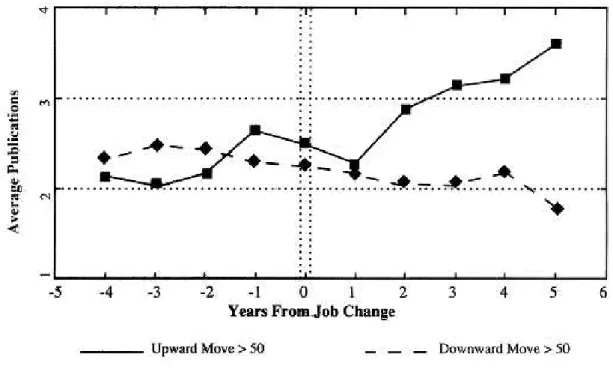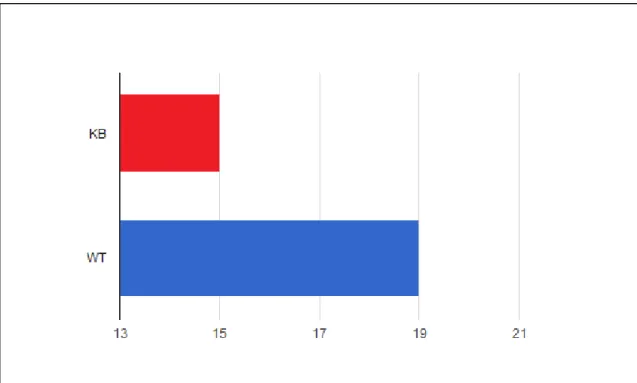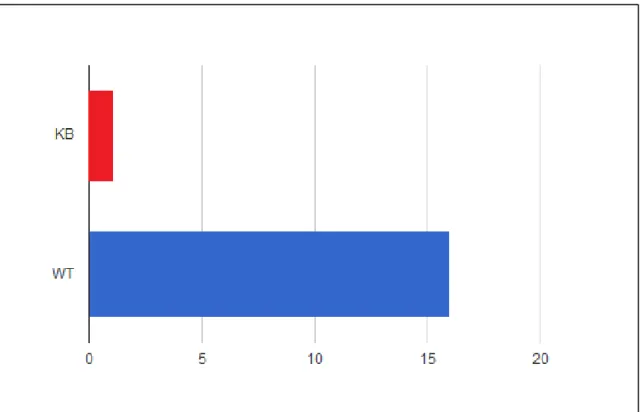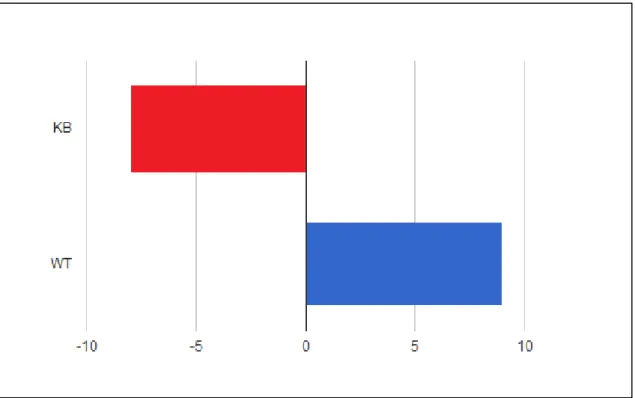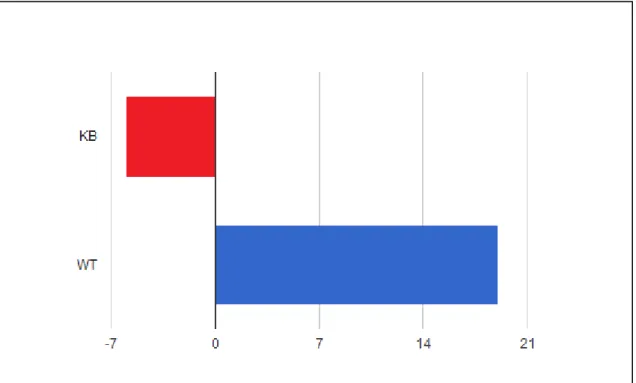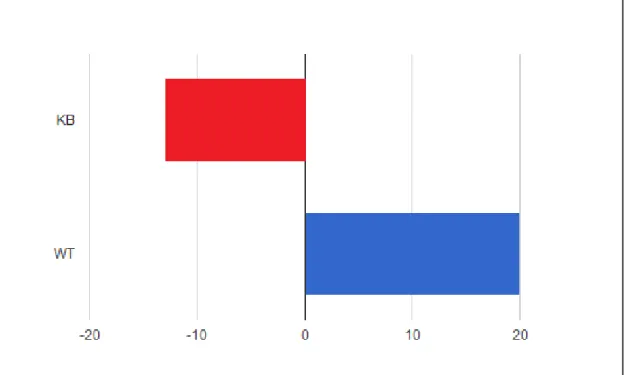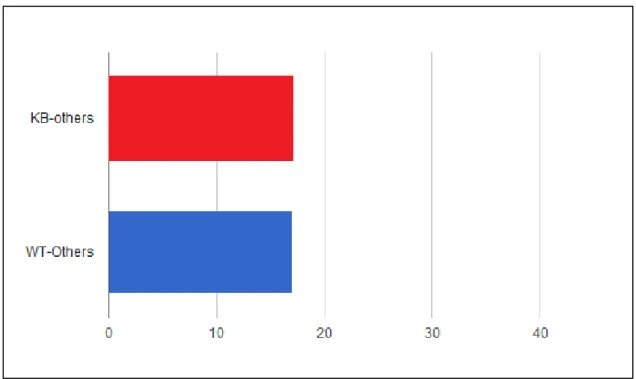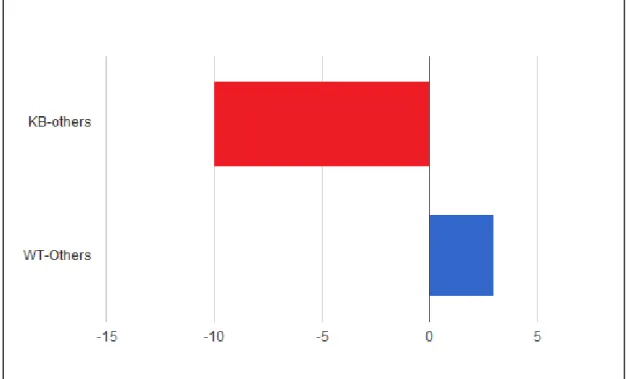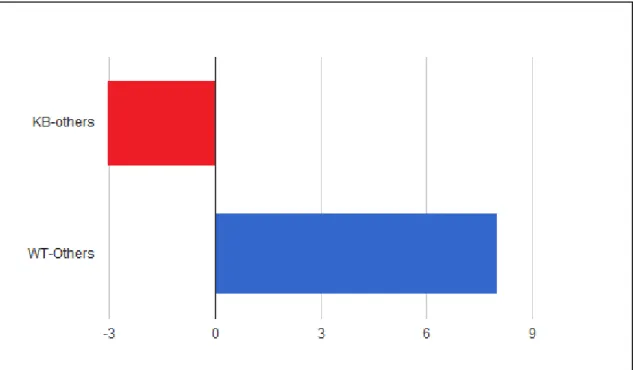FUNDAÇÃO GETULIO VARGAS
ESCOLA BRASILEIRA DE ADMINISTRAÇÃO PÚBLICA E DE EMPRESAS
CENTRO DE FORMAÇÃO ACADÊMICA E PESQUISA
MESTRADO ACADÊMICO EM GESTÃO EMPRESARIAL
Dissertação:
PRIMED AND PREJUDICED: THE KURANTA-BOTHATA STUDY
Luiz Carlos Victorino de Souza Junior Matrícula: 103105006
por
Luiz Carlos Victorino de Souza Junior
Professor Orientador: Alexandre Linhares
Dissertação apresentada como pré-requisito para a conclusão do curso de Mestrado Acadêmico em Gestão Empresarial da Escola Brasileira de Administração Pública e de
Empresa da Fundação Getulio Vargas. Orientador: Professor Alexandre Linhares
ABSTRACT
possible. Also, I would like to thank my family: My parents, Luiz and Lucia, for all the support throughout the years and all the effort invested in me. My sister Livia, who fights in the academic battlefield as I do, for the example of energy and hard-work. My grandmothers Lea and Marilia, for trying to spoil me and making such a good job. Thanks to my wife Sarah for letting me build my world of dreams around her - I'm so glad that I have found you. All my family, old and new, thanks for trusting and supporting me. I hope I can make you as proud of me as I am of you.
I would like to thank Professor Alexandre Linhares for believing in my potential on my admission interview. That day changed my life. I also have learned googols of things during our meetings and this changed my life as well.
I would like to thank my friends, whom in the words of Shakespeare, are “the family we choose for ourselves”.
Finally, I would like to thank my friends from FGV: our journey was ardorous, treacherous and sometimes frightenly lonely, but we stood together and together we have succeeded. For you, I dedicate this quote from The Lord of The Rings, by J.R.R. Tolkien:
SUMMARY
1 INTRODUCTION ... 1
2 THEORETICAL FRAMEWORK ... 5
3 MATERIALS AND METHODS ... 7
3.1 Design and Procedure ... 7
3.2 Participants ... 7
3.3 Materials ... 7
3.4 Data Collection... 8
4 RESULTS ... 9
5 CONCLUSION ... Error! Bookmark not defined. 6 REFERENCES ... 21
7 APENDIX A – Questionaire (Pre-test) ... 25
8 APENDIX B – Kuranta-Bothata Scientific Paper ... 26
9 APENDIX C – Welgesteld-Tijdschrift Scientific Paper ... 43
Figure 1 - After (ALLISON & LONG, 1990). The average number of publications versus time, when a researcher changes address from a high (low) prestige institution to a low (high) one ... 3 Figure 2 - After (ALLISON & LONG, 1990). The average number of citations across
time, when a researcher changes address from a high (low) prestige institution to a low (high) one. ... 3 Figure 3 - Deviation from the neutral position on the question “Do you think this paper
is original?”. ... 9 Figure 4 - Deviation from the neutral position on the question “Do you think the area of research of this paper will grow in the future?”. ... 10 Figure 5 - Deviation from the neutral position on the question “Do you think this paper
is well-executed? Is the methodology sound?”. ... 10 Figure 6 - Deviation from the neutral position on the question “Do you think the
conclusions are warranted?”. ... 11 Figure 7 - Deviation from the neutral position on the question “Do you think this paper
is suitable for publication?”. ... 12 Figure 8 - Deviation from the neutral position on the question “Would you authorize the
authors to receive funding for extending this research?”. ... 13 Figure 9 - Deviation from the neutral position on the question “Would you cite this
paper if you eventually produce work on a related area?”. ... 13 Figure 10 - Deviation from the neutral position on the question “Do you think others
will find this paper original?”. ... 15 Figure 11 - Deviation from the neutral position on the question “Do you think others
will find that the area of research of this paper will grow in the future?” ... 16 Figure 12 - Deviation from the neutral position on the question “Do you think this paper
is well-executed? Is the methodology sound?”. ... 16 Figure 13 - Deviation from the neutral position on the question “Do you think others
will find the conclusions warranted?”. ... 17 Figure 14 - Deviation from the neutral position on the question “Do you think others
Figure 15 - Deviation from the neutral position on the question “Do you think others would authorize the authors to receive funding for extending this research?”. ... 18 Figure 16 - Deviation from the neutral position on the question “Do you think others
will cite this paper if producing work on a related
area?”……….……….18
1 INTRODUCTION
Science stands on the process of peer review. Peer review aims to assure reasonable and fair consideration of scientific papers--and not only for publishing in journals but also for research funding, tenure, prize awarding and so forth. Even though among journals (and institutions) there are small differences in the procedure itself, the process is based on the concept of scientific experts analyzing and scrutinizing studies in their specific field, in order to determine which ones are publishable, how revisions should be conducted, or if publication should be supported by a journal.
Such evaluation is carried out to verify if a study is well conducted, its methodology is adequate and, obviously, if the results are significant. Since those specialists conducting the review are experienced in publishing in the field, it is reasonable to assume that the process enhances the development of specific knowledge.
Nevertheless, the equality and transparency of the process is far from achieving a consensus, and questions concerning biases in the traditional peer review have been brought to attention in many fields. Many journals are currently experimenting with alternative models, such as: i) double-blind review, in which not only referees are undisclosed, but also the names and addresses of authors; ii) published review, in which the review (and referee's name) is made public, alongside the published article; or even iii) open peer review, in which submitted papers can be reviewed by anyone with an interest in reviewing a particular paper (for a well-known experiment in this regard conducted by the journal Nature, see Greaves et. al., 2006).
"There is no question in my mind that there is some inherent prejudice in the minds of some referees in the West about authors from Third World countries,” says C.N.R. Rao, president of the Jawaharial Nehru Center for Advanced Scientific Research in Bangalore. "Referees tend to feel that good work could not have been done in a developing country. I have published in major journals of the world for the past 40 years, but even now I face some prejudice from referees. This is not infrequent." (GIBBS 1995, p. 82)
Some scientists who have moved from industrial to less developed countries have found that the address change makes a difference to reviewers.
"When I was a resident in Boston, I was able to publish papers in the American Journal of Pathology with a couple of well-known pathologists," Benítez says, "They flew through to publication with no problem. After that, I went to the University of Bonn in Germany and published two papers in Nature. Then I came back to Mexico with more experience and maturity. But now when I have sent papers to the same journals, they have been rejected immediately" (GIBBS 1995, p.81--82)
Other studies have also indicated flaws on the peer review process, such as a paper published in Science, which have found that getting a research grant, even though conducted through a peer review process, depended "to a significant extent on chance" (Simon, Cole & Cole, 1981, p.881).
factors other than competence and maturity influence scientific recognition, and our aim in this work is to conduct a controlled experiment of the peer review process.
Figure 1. (After ALLISON & LONG, 1990). The average number of publications versus time,
when a researcher changes address from a high (low) prestige institution to a low (high) one.
Figure 2. After (ALLISON & LONG, 1990). The average number of citations across time, when
Despite the fact that there is some empirical evidence to back the idea of biases in the peer review process, our knowledge of such biases is limited, as few studies have been provided in the literature, and most of them concern specificities of different fields, and not the phenomenon itself.
As the basis of the peer review process is the evaluation and judgment of specialists (CECI & PETERS, 1982), to understand and avoid the biases in the peer review process, it is necessary to investigate how paper evaluation (and judgment concerning the publish-ability of a paper) can be affected, hence, influencing the peer review process (SMITH, 2006). The next chapter provides a background of the psychological mechanisms of prejudice and stereotyping: priming.
2 THEORETICAL FRAMEWORK
There are numerous situations in which stereotyping and judgment are connected, and understanding this relation can improve evaluation processes (Herr, 1986; Steele and Aronson, 1995; Stangor, 2000). On the present study, we focus on scientific papers evaluation, and how the stereotype of a low-prestige institution, or of a low-prestige country, can affect evaluation and judgment of a scientific paper. There is literature showing stereotyping in judgment and evaluation of scientific papers (Swim, et.al., 1989; Monaham, Brown & Shtrulis, 2003) and, since the works of Cole and Cole (1973) and Hagstrom (1968) it seems that scientists at prestigious universities tend to have higher rates of publication and higher rates of citation, in part attributable to the prestige of their institutions--even if we consider that prestigious institutions have better research centers, superior infrastructure, attract better scientists and that, developed countries usually have well-developed scientific incentive programs and higher investments on science, it is reasonable to think that this will have an impact on their scientific production.
It is important to highlight that stereotyping and prejudice are different constructs. Steele and Aronson (1995) described stereotypes as “standardized and simplified conceptions of groups based on some prior assumptions”. Actually, stereotyping is a cognitive strategy, with evolutionary origins stemming from the beginnings of the human race, to optimize mental processing. After labeling a person, an object, or a situation, it is easier for the brain to identify and react (Kleg, 1993). Researchers have even shown that, depending on the situation, stereotypes could be very accurate (Nelson, 2009; Lee, Jussim & McCauley, 2005). The interesting fact about stereotyping, and the focus of the present study, is that stereotypes can be activated even when the stimulus presented is unknown--that is, when the brain makes connections with past experiences in order to develop a subsequent coherent response (Macrae, Stangor & Milne, 1994; Oliner, 2001). Which means that, even when something is shown for the first time, based on our previous experiences, we automatically develop a labeling process which will influence our present and future responses to that stimulus (Greenwald & Banaji, 1995).
associations unconsciously and affortlessly. A particularly intriguing cognitive phenomenon known as priming has been gaining more attention in the last years, not only for its potential to influence behaviour, but also for its widespread presence (Bargh, Brownell & Harris, 2009). Priming could be defined as “a process in which an individual is exposed to a stimulus that influences the response to a subsequent stimulus” (Kolb & Wishaw, 2003, p. 453). The literature on priming is extensive on how it can influence the basic processes of evaluation and judgment (Phillipot et.al.1991, Mussweiler & Strack, 2000), and the consequences of this influence in different scenarios, for example, in financial behavior (Gilad & Kliner, 2008).
The cognitive process behind priming is still not completely described, but the standard perspective is that, once a particular stimulus is shown, it activates neural networks through a process called spreading activation (Reisberg, 2007)--the stimulus activates pieces of information in memory that are related or associated to the content, influencing the response to the stimulus (Bargh & Chartrand, 2009). And since the activation of those networks is not conscious, there is no participation of conscious will in the process (Bargh,1982).
A good example is the research conducted with rude and polite stimuli, when subjects primed with rude words were significantly more likely to interrupt a person than those primed with neutral words. And also, the subjects primed with polite words were the least likely to interrupt in the same situations (Bargh, Chen & Burrows, 1996), Even a simple stimulus, like holding a hot or cold beverage just before an interview has influenced the opinion of the subjects towards the interviewer (Williamns & Bargh, 2008). It is well accepted – and different researchers have been proving - that not only simple and basic responses can be primed, but even extremely complex cognitive processes can be affected nonconsciously through priming, such as use of social norms (Aarts & Djiksterhuis, 2003), egalitarian behavior (Bargh, et al 2001), cultural ideologies (Nisbett, 2003) and, the focus of the present study, judgment and stereotypes (Bargh, 2006; Ferguson, Bargh & Nayak, 2005;and Djiksterhuis & Bargh, 2001).
3 MATERIALS AND METHODS
3.1 Design and Procedure
Participants were given a scientific article to read with no time restraint. After reading the article and giving it back, they should answer a questionnaire to evaluate the article.
On the article given, a footnote contained a piece of information to trigger the priming effect. A pretest was conducted to evaluate the effect of the priming factors used on the main experiment.
3.2 Participants
For the pretest, 63 undergraduate students of business administration from a major Brazilian university participated voluntarily.
For the main experiment, participants were randomly selected from the largest administration academic conference in Brazil, in a total of 80 participants between coordinators, professors and students from master and doctor programs, who also participated in the experiment voluntarily
3.3 Materials
A seventeen-page scientific article on the area of general management was formatted as such, but with the only information available being the text itself and the footnote regarding the funding institution. There was no other information disclosed, such as author’s name or university.
There were two conditions: On condition 1, the footnote informed that the research was financed by the High Scientific Council of the Welgesteld-Tijdschrift Province. On condition 2, with the exact same paper, the footnote informed that the research was financed by the High Scientific Council of the Kuranta-Bothata Province.
pretest was conducted to test the hypothesis that, for Portuguese speakers, the word Welgesteld-Tijdschrift resembles some sort of European language, and, on the other side, Kuranta-Bothata has an african similitude. The results of the pretest confirmed this hypothesis.
3.4 Data Collection
For the pre-test, a one-page questionnaire was used to determine the priming effect of the words chosen for the funding institutions (“Welgesteld-Tijdschrift” and “Kuranta-Bothata”). This questionnaire had five questions. The first four, asking which of those institutions were more prestigious, to which would the respondent apply for a master program, which seemed more reliable as far as scientific production was concerned and from which institution would they like to receive information about courses, post-graduate programs and academic exchange. On the last question, respondents were asked about the origin country of each institution and which of those seemed more social and economic developed.
4 RESULTS
The questionnaires were analyzed based on the responses given through a Likert Scale, from 1 (completely disagree) to 5 (completely agree). Given that 3 was the neutral response (not agreeing or disagreeing), for a better visualizations of the results, we have translated the scale to a scoreboard (e.g., the scale's neutral response 3 is equal to 0, and the scale 1 to 5 was translated to the range [-2,+2], and we look at the sum totals).
Figure 3. Deviation from the neutral position on the question “Do you think this paper is original?”.
Figure 4. Deviation from the neutral position on the question “Do you think the area of research
of this paper will grow in the future?”.
Similarly to the previous item, this question showed no meaningful difference between the two conditions, with KB reaching 15 points and while WT reaching 18, and again, this question was tangential to the effect because the growth of an area is not related to the quality of a paper. There are good papers in declining areas and low-quality papers in growing areas.
Figure 5. Deviation from the neutral position on the question “Do you think this paper is
Even though the scores for both conditions were positive, a meaningful difference was found, with the KB condition reaching 1 point and the WT condition reaching 16. That is, subjects seem neutral in regards to KB, but have a generally positive view of the WT condition. Unlike the first two questions, the execution and the methodology of a paper are linked to its quality, which could indicate a effect caused by the conditions presented.
Figure 6. Deviation from the neutral position on the question “Do you think the conclusions are
warranted?”.
Figure 7. Deviation from the neutral position on the question “Do you think this paper is suitable for publication?”.
For this question, the KB condition reached -6 points while the WT condition reached 19. Not only the negative tendency for the KB condition, but also the positive and expressive score of the WT condition, reinforce the effects of priming in the perception of quality.
Figure 8. Deviation from the neutral position on the question “Would you authorize the authors to receive funding for extending this research?”.
Receiving funds for extending the research not only is related to the quality of a paper, but also indicates that it has potential to reach relevant results in the future. The results for this item were -13 for the KB condition and +20 for the WT condition, which gives a good evidence that the priming stimulus had an effect on the perception of quality.
With a score of -15 for the KB condition and +21 for the WT condition, this item showed the largest difference between the results achieved. Not only it indicates the negative effect caused by the KB condition and the positive effect caused by the WT condition, but also this is the only item which contains a more personal/behavioral aspect. The act of citing a scientific paper not only denotes the quality of the cited paper, but through linking it to the work on progress, also indicates the relevance of the contribution given by the cited article.
Analyzing the results for the first part of the questionnaire (in which the respondents showed their own opinions about the paper), the effect of the priming stimulus on the subjects was evidenced by the negative scores reached by the KB condition and the positive scores reached by the WT condition. The respondents on the KB condition showed a tendency of giving negative grades for the paper in most of the evaluated aspects, and similarly, the respondents on the WT conditions evaluated the paper more positively.
Not only the negative and positive trends are relevant, but also the quantitative differences in the scores for both conditions--perceptible mainly on the aspects directly linked to the quality of the paper.
The tangential aspects showing a lighter effect, actually ends up reinforcing the evidence on the priming effect causing the perception differences between KB and WT conditions, since the more linked to the quality the aspect was, the larger the difference between the scores.
Evidently, it does not mean that the peer review system has a established bias, and that is not even the objective of the present study, but it indicates that a subtly presented stimulus (such as two words on a footnote) can trigger a priming process that alters the perception of the subject, hence affecting its judgment towards an object.
Even though the subjects were not all reviewers, all of them had experience in evaluating papers, since it is part of their daily activities, as either graduate students or faculty.
On the second part of the questionnaire, the respondents were asked how others would evaluate the scientific paper in the same aspects as they had evaluated it. The objective of this part was to investigate if the conditions would be present not only on the respondents’ opinion, but also on their impressions on the opinions of others.
The results on the second part, shown on figures 10--16, followed the same trends perceptible on the first part, but were less striking. Although we were unable to identify the causes for this effect, we hypothesize that the respondents were uncertain or unsure of the opinion of others, and tended to score more neutrally.
Figure 10. Deviation from the neutral position on the question “Do you think others will find this
Figure 11. Deviation from the neutral position on the question “Do you think others will find that the area of research of this paper will grow in the future?”.
Figure 12. Deviation from the neutral position on the question “Do you think this paper is well
Figure 13. Deviation from the neutral position on the question “Do you think others will find the conclusions warranted?”.
Figure 15. Deviation from the neutral position on the question “Do you think others would authorize the authors to receive funding for extending this research?”.
5 CONCLUSION
Numerous authors have argued that there may be bias in the peer-review system (Langfeldt, 2006; Marsh, Jayasinghe & Bond, 2008; Lane & Linden, 2009). In the aforementioned "lost science in the third world" study, for instance, some Brazilians (among others) argue that there is serious bias against authors from low-income countries (including Brazil). In this work we turn the tables and argue that Brazilians also display bias towards low-income countries--our controlled experiment shows subjects heavily skewed towards authors from European-sounding institutions, as opposed to authors from African-sounding institutions.
Perhaps our results can be generalized to the pool of scientific journal referees. But perhaps that would be a stretch too far of what we have found here. Certainly, our evidence is limited and our experiment does not immediately warrant this conclusion, for two reasons. First, consider the timing and effort involved in reviewing a journal paper. Referees, depending on the specialty and the journal, may have from weeks to months to evaluate a manuscript. Of course, in practice, referees do not use this allotted time exclusively on manuscript evaluation, but must balance this task against a background of other activities.
It is also possible that subjects that usually referee articles would reject our request for participation in this study, lacking the incentive of formal journal recognition to carry out a task that they may find routine and perhaps burdensome. It is hard to control against this adverse selection effect, unless one selects as subjects only those with journal refereeing experience; this is something we believe should be addressed in further work.
However, even if our subjects may not be a good reflection of the referee pool, and even if we may have a particularly inadequate sample in what refers to top-quality business and management journals (e.g., few of our subjects were authors of papers in such journals), all of our subjects could have been referees for the Enanpad conference (which is the world's 2nd largest management conference by number of presentations), and there is nothing to suggest that this sample of subjects is specially biased or prejudiced.
6 REFERENCES
AARTS, H. & DIJKSTERHUIS, A. (2003) The silence of the library: environment, situational norm and social behavior. Journal of Personality and Social Psychology. v.84, n.1, 18-2.
ALLISON, P.D. & LONG, J.S. (1990). Departmental effects on scientific productivity. American Sociological Review.v.55, n.4, 469-478.
BARGH, J. A. (1982). Attention and automaticity in the processing of self-relevant information. Journal of Personality and Social Psychology, v,43, 425-436.
BARGH, J. A. (2006). What have we been priming all these years? On the development, mechanisms, and ecology of nonconscious social behavior. European
Journal of Social Psychology.v.2, 243-257
BARGH, J.A., BROWNELL, K.D. & HARRIS, J.L. (2009) Priming effects of television food advertising on eating behavior. Health Psychology. v.28, n.4, 404-413. BARGH, J.A., CHEN, M. & BURROWS, L. (1996) Direct effects of trait construct and stereotype activation on action. Journal of Personality and Social Psychology, v.71, n.2, 230-244.
BARGH, J.A., GOLLWITZER, P.M., LEE-CHAI, A., BARNDOLLAR, K. & BARGH, J.A. & CHARTRAND, T.L. (1999) The unbearable automacity of being. American
Psychologist. v.54, n.7, 462-479.
CECI, S.J. & PETERS, D.P. (1982). Peer review – a study of reliability. Change. v.14. 44-48.
COLE, J.R. & COLE, S. (1973) Social stratification in science. Chicago, Il. University of Chicago Press.
FERGUSON,M. J., BARGH, J. A., & NAYAK, D. A. (2005). After-affects: How automatic evaluations influence the interpretation of subsequent, unrelated stimuli. Journal of Experimental Social Psychology, v.41, 182-191.
GIBBS, W.W. (1995) Lost science in the third world. Scientific American. v.273, n.22, 76-83.
GILAD, D. & KLINER, D. (2008), Priming the risk attitudes of professionals in financial decision making. Review of Finance. v.12, n.3, 567-586.
GREENWALD, A.G. & BANAJI, M.R. (1995) Implicit social cognition: attitudes, self-steem and stereotypes. Psychological Review, v.102, n.1, 4-27.
GREAVES, S., SCOTT, J., CLARKE, M. & MILLER, L. (2006) Nature’s trial of open peer review. Nature v. 444, n. 971, 21-28.
HAGSTROM, W.O. (1968) Departmental prestige and scientific productivity.
Sociological Abstracts. v.34, n.7. 123-138.
HERR, P.M (1989) Consequences of priming: judgment and behavior. Journal of
Personality and Social Psychology.v.51, n.6 1106-1115.
KLEG, M. (1993) Hate prejudice and racism.New York. State University of New York Press.
KOLB, B. & WHISHAW, I.Q. (2003) Fundamentals of human neuropsychology. New York, Worth Publishing.
LANE, J.A. & LINDEN, D. Is there genders bias in the peer review process at journal of neuropsychology? Journal of Physhiology. v.101, n.5 05-26.
LANGFELDT, L. (2006) The policy challenges of peer review: managing bias, conflict of interests and interdisciplinary assessments.Research Evaluation. v.15, n.1. 31-41 LEE, Y.L., JUSSIM, L. & McCAULEY, C.R. (2005). Stereotype accuracy: toward appreciating group differences. American Psychological Association. v.105, n.3. 178-188.
productivity of graduates in management: effects of academic origin and academic affiliation. The Academy of Management. v.41, n.6. 704-714.
MACRAE, C.N., STANGOR, C. & MILNE, A.B. (1994) Activating social stereotypes: a functional analysis. Journal of Experimental Social Psychology. v.30, n.87, 370-389. MARSH, H., JAYASINGHE, U.,& BOND, N.W. (2008) Improving the peer-review process for grant applications: reliability, validity, bias, and generalizability. American
Psychologist, v.63, n.3, 160-168.
MENEGHINI, R., PACKER, A.L. & NASSI-CALÓ, L. (2008) Articles by latin american authors in prestigious journals have fewer citations. PLoS One. Available in http://www.plosone.org/article/info%3Adoi%2F10.1371%2Fjournal.pone.0003804 Access in 21st November, 2010.
MONAHAN, J.L., BROWN, G.S.M. & SHTRULIS, I. (2003). Priming and stereotyping: how mediated images affect perceptions in interpersonal contexts.
International Communication Association Review. v.209, 72-79.
MUSSWEILER, T. & STRACK, F. (2000) The use of category and exemplar knowledge in the solution of anchoring tasks. Journal of Personality and Social
Psychology., v.78,1038-1052
NELSON, T.D. (2009) The unbearable accuracy of stereotypes. In. Handbook of
prejudice, stereotyping and discrimination. Psychology Press.
NISBETT, R.E. (2003) The geography of thought: how Asians and westerners think differently and why. New York, Free Press.
OLINER, A. (2001) The cognitive roots of stereotyping. Psychologist, v.35, 662-668. PHILLIPPOT, P., SCHAWRZ, N., CARRERA, P., DE VRIES, N. & VAN YPEREN, N.W. (1991). Differential effects of priming at the encoding and judgment stage.
European Journal of Social Pshychology. v.21, 293-302.
SIMON, G.A., COLE, J.R. & COLE, S. (1981). Chance and consensus in peer review.
Science. v.214, n.4523
SMITH, R. (2006) Peer review: a flawed process at the heart of science and journals.
Journal of The Royal Society of Medicine. v.99, n.4, 178-182.
STANGOR, C. (2000). Key Readings in Social Psychology: Stereotypes and prejudice. Levittown, PA:Psychology Press.
STEELE, C.M. & ARONSON, J. (1995) Stereotype threat and the intellectual test performance of african americans. Journal of Personality and Social Psychology. v.69. n.5 797-811.
SWIM, J., BORGIDA, E., GEOFFREY, M. & MYERS, D.G. (1989) Joan mckay versus john mckay: do gender stereotypes bias evaluations? Psychological Bulletin, v.105, n.3, 409-429.
7 APENDIX A – Questionaire (Pre-test)
Questionnaire
Welgesteld-Tijdschrift and Kuranta-Bothata are two foreign institutions that are planning to start working with Brazilian students. Since both institutions are not known in Brazil, it is important to evaluate the perception of Brazilian students regarding the institutions. Please, answer the following questions simply choosing one of the institutions.
Which institution is more prestigious?
( ) Welgesteld-Tijdschrift ( ) Kuranta-Bothata
For which institution would you apply for a master program?
( ) Welgesteld-Tijdschrift ( ) Kuranta-Bothata
Which institution seems to be more reliable, as far as scientific production is
concerned?
( ) Welgesteld-Tijdschrift ( ) Kuranta-Bothata
From which institution would you like to receive information on courses,
post-graduate programs and academic exchange opportunities?
( ) Welgesteld-Tijdschrift ( ) Kuranta-Bothata
From which country or continent do you believe these institutions are from?
Welgesteld-Tijdschrift _________________________
Kuranta-Bothata ____________________________
Which of those institutions seems to be from a more social and economic
developed country?
( ) Welgesteld-Tijdschrift ( ) Kuranta-Bothata
9 APENDIX C – Welgesteld-Tijdschrift Scientific Paper (the other 16 pages
are the same as on Apendix B).
10 APENDIX D – Scientific Paper Evaluation Form
Questionnaire
Paper Evaluation Form
#1. Do you think this paper is original?
1. 2. 3. 4. 5.
Not at all original Extremely innovative
#2. Do you think this paper is well-executed? Is the methodology sound? 1. 2. 3. 4. 5.
There are serious flaws Extremely well-executed
#3. Do you think the conclusions are warranted?
1. 2. 3. 4. 5.
The conclusions do NOT follow from the paper The conclusions clearly follow from the paper.
#4. Do you think the area of research of this paper will grow in the future? 1. 2. 3. 4. 5.
Not at all This area will have immense growth
#5. Would you authorize the authors to receive funding for extending this research?
1. 2. 3. 4. 5. Not at all Absolutely, further research deserves funding
#6. Do you think this is suitable for publication?
1. 2. 3. 4. 5.
Not at all this paper should be published in a top-journal
#7. Would you cite this paper if you eventually produce work on a related area?
1. 2. 3. 4. 5.
Not at all Yes, absolutely.
================================
Given the time you have allocated to this paper, how would do you think OTHERS would rate it in the following 7 dimensions?
#8. Do you think others will find this paper original?
1. 2. 3. 4. 5.
Not at all original Extremely innovative
#9. Do you think others will find this paper well-executed? Would others find the methodology sound?
1. 2. 3. 4. 5. There are serious flaws Extremely well-executed
#10. Do you think others will find the conclusions warranted? 1. 2. 3. 4. 5.
The conclusions do NOT follow from the paper The conclusions clearly follow from the paper.
1. 2. 3. 4. 5.
Not at all This area will have immense growth
#12. Do you think others would authorize the authors to receive funding for extending this research?
1. 2. 3. 4. 5. Not at all Absolutely, further research deserves funding
#13. Do you think others will find that this is suitable for publication? 1. 2. 3. 4. 5.
Not at all This paper should be published in a top-journal
#14. Do you think others will cite this paper if producing work on a related area?
1. 2. 3. 4. 5.
Not at all Yes, absolutely.
=================== Thank you for participating in this study!
Can you guess what the intent of this research is? NO YES:
Would you like to receive a copy of the paper you have evaluated? NO YES, my email is
___________________________________________________________
Would you like to be informed of the intent and results of this study? NO YES, my email is
___________________________________________________________
What is your highest degree? _____________________ PQ/CNPq? ______________
What is your affiliation?
____________________________________________________
What is your position?
______________________________________________________
